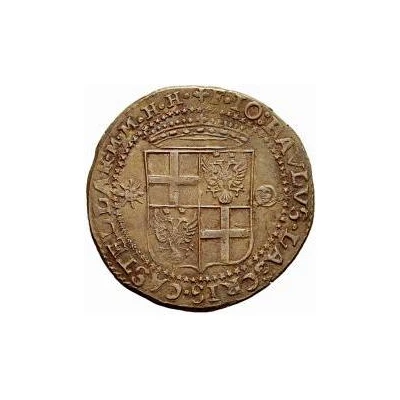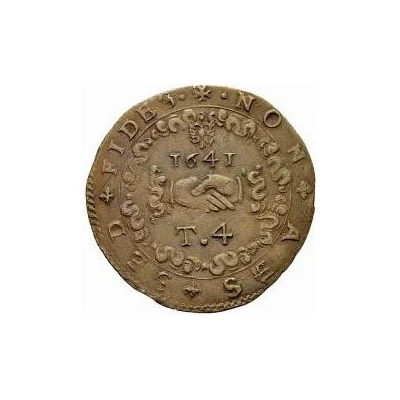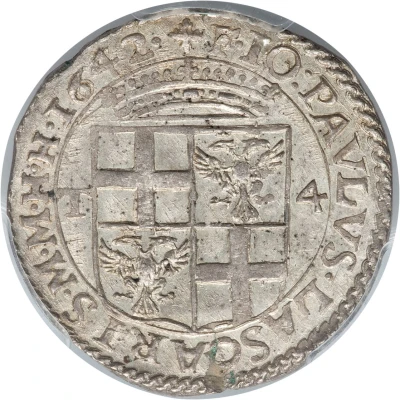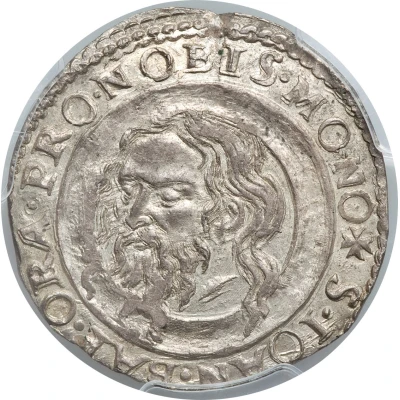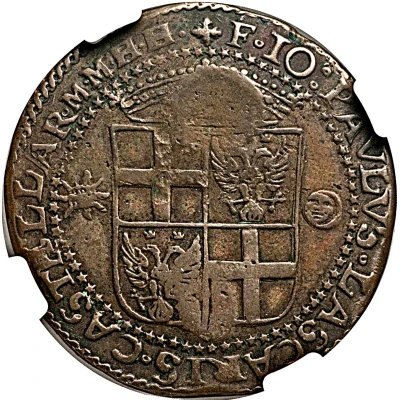
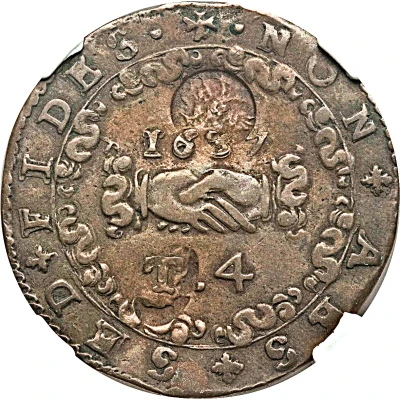

4 Tari Countermarked ND
| Copper | - | - |
| Issuer | Malta |
|---|---|
| Type | Standard circulation coin |
| Years | 1636-1651 |
| Value | 4 Tari (⅓) |
| Currency | Scudo (1530-1825) |
| Composition | Copper |
| Shape | Round |
| Technique | Countermarked |
| Orientation | Medal alignment ↑↑ |
| Demonetized | Yes |
| Updated | 2024-10-06 |
| Numista | N#96679 |
|---|---|
| Rarity index | 92% |
Reverse
Within circle, clasped hands, value below and date above.
Countermarks randomly placed.
Script: Latin
Lettering:
·NON AES SED FIDES·
1637
T . 4
Translation: Not money but trust
Comment
Countermarks employed by Order to validate copper coinage
1) Double-headed eagle within a circular impression (approximate diameter of 6-7 mm).
Countermark of Jean Paul Lascaris Castellar (1636-1657).
Countermark authorized by decrees of 1646, May 17th and 1646, May 28th.
2) Double-headed eagle within a shield impression (5 mm x 6.5 mm).
Countermark of Jean Paul Lascaris Castellar (1636-1657).
Countermark authorized by decrees of 1646, May 17th and 1646, May 28th.
3) Head of St. John the Baptist within an oval impression (approximate 4.5 mm x 7 mm).
Countermark of Raphael Cotoner (1660-1663).
Countermark authorized by decree of 1662, April 19th.
4) Crowned fleur-de-lys within an irregular impression (approximate 4.5 mm x 7.5 mm).
Countermark of Adrien Wignacourt (1690-1697).
Countermark authorized by decree of 1696, August 27th.
5) Crowned star within an irregular impression (approximate 10 mm x 7 mm).
Countermark of Raymond Despuig (1736-1741).
Countermark authorized decree of 1740, December 13th.
6) Crowned crescent within an irregular impression (approximate 6 mm x 10 mm).
Countermark of Emmanuel Pinto (1741-1773).
Countermark authorized by decree of 1741, January 31st.
7) MA monogram within an irregular impression (approximate 6.5 mm x 7 mm).
Countermark Emmanuel Pinto (1741-1773).
Countermark authorized by decree 1766, May 30th.
8) Crowned diamond within an irregular impression (approximate 5 mm x 7 mm).
Countermark of Emmanuel de Rohan (1775-1797).
Countermark authorized by decrees of 1777, June 19th and 1778, January 10th.
9) Paschal lamb with banner of the Order within an octangular impression (approximate 6 mm x 6.75 mm).
Countermark of Emmanuel de Rohan (1775-1797).
Countermark authorized by decrees of 1792, July 17th and 1792, October 29th.
- It appears that countermarks #1 and #2 are merely distinctive varieties of the countermarking authorized in 1646. Also, the countermark #2 seems to be the more uncommon of the two varieties. Countermark #2 only appears on coins issued before Lascaris, for example of De La Valette or Verdala. Countermark #1 is only used for Lascaris coins.
- The countermark #5 is reported to be the most uncommon of all the countermarks. This is attributed to the death of Despuig within months of the authorization of his reign's countermarking.
- Schembri Pridmore and other early sources erroneously attributed the countermark #9 to the reign of Grand Master Raymond Perellos (1697-1720). Sammut's work has definitively attributed this countermark to Rohan's reign.
Examples of 1, 3, 4, 5 (obscured), 7, 8, 9:
Interesting fact
One interesting fact about the Standard circulation coin 4 Tari (Countermarked) ND (1636-1651) from Malta made of Copper is that it was issued during the reign of Grand Master Juan de Lascaris-Castellar, who was the 52nd Grand Master of the Order of Saint John (also known as the Knights Hospitaller) and ruled Malta from 1636 to 1651. This coin was part of a series of coins that were issued during his reign to help stabilize the Maltese economy, which had been struggling due to the effects of the Thirty Years' War in Europe. The coin features the coat of arms of the Order of Saint John on one side and the image of a cross on the other, and its countermarking indicates that it was issued by the Maltese authorities. Today, this coin is considered a rare and valuable collector's item, with some examples selling for thousands of dollars at auction.
